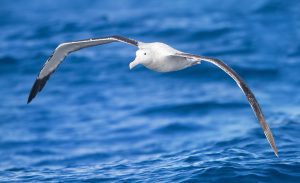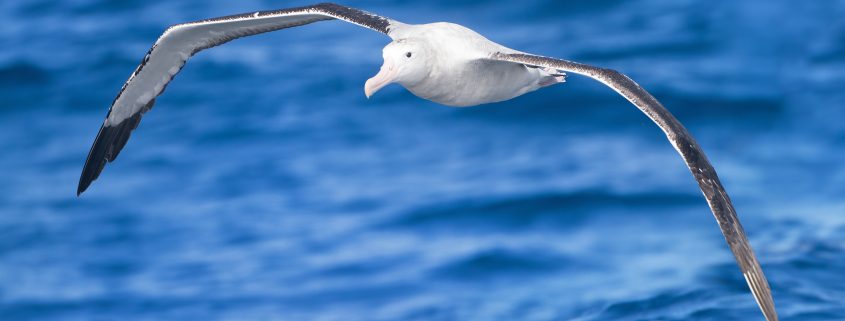Challenges in seabird by-catch mitigation
By Hanover Matz, RJD Intern
In this paper, the authors comment on the current conservation status of seabirds and attempts to limit seabird deaths due to by-catch. Two species of seabirds, the albatrosses and the petrels, are particularly vulnerable to the detrimental effects of fisheries such as longlining. These birds normally lay only one egg per clutch and breed infrequently. They have long maturation and generation times compared to other birds, making it more difficult for their populations to recover from high mortality. They are also capable of flying long distances in search of food, crossing many different marine environments. This makes it difficult to implement conservation methods that can protect these birds in every part of the world they inhabit. Some of these species are already considered endangered or critically endangered. In order to fully protect them, an international effort is necessary.

A wandering albatross (Diomeda exulans) off Tasmania, Australia. Photo courtesy of JJ Harrison via Wikimedia Commons
Seabirds and human fisheries come into conflict in many of the most productive regions of the ocean, specifically around New Zealand and Australia, the Humboldt Current off Chile, Peru, and Ecuador, the North Pacific, and South Africa. Seabirds are known to be killed as accidental by-catch in longline fisheries, and growing evidence has shown incidental catch of seabirds by trawlers. One difficulty in assessing whether trawling or longlining presents a greater threat to seabirds is the low proportion of entangled seabirds actually recovered from trawling gear. If the birds that collide with the gear cannot be retrieved, it is hard to assess the impact the fishery has. Refining the collection of data on how many seabirds are killed by longlining and trawling will improve conservation efforts.
In South Africa, the use of bird-scaring lines (BSLs) in fisheries has been shown to reduce the mortality of seabirds up to 95%. The trawl fishery previously had proportionally high incidental catches of albatrosses, making this a significant success in terms of protecting threatened species. However, to fully determine how well seabird mortality has been reduced, better data needs to be collected on both the level of by-catch and fishing effort. To reduce the by-catch of seabirds and improve conservation worldwide, the authors stress four important strategies. First, mitigation methods need to be improved with better data and techniques, considering each fishery individually and adapting the methods as necessary. Second, the quality of data collected needs to be increased by improving the programs used to collect it. Third, the fishing industry needs to be engaged by implementing and enforcing by-catch reduction, as well as cooperating to suit the needs of both the fishery and conservation. Finally, cooperation between governments, administrators, and decision makers is necessary to promote better fishing practices and conservation measures. In some fisheries, seabird by-catch mitigation is minimal or nonexistent. While trawling and longlining have been addressed, the effects of purse-seine and gill net fisheries are poorly understood. The threat posed by small scale and artisanal fishing fleets has also not been widely considered. If threatened seabird species are to be protected, it will require both national and international efforts. By improving the science behind the conservation, and cooperating with both governments and fisheries, scientists and conservations will be better able to address this conservation issue in the coming future.
References
1. Favero, M., & Seco Pon, J. P. 2014. Challenges in seabird by‐catch mitigation. Animal Conservation, 17(6), 532-533.




Leave a Reply
Want to join the discussion?Feel free to contribute!